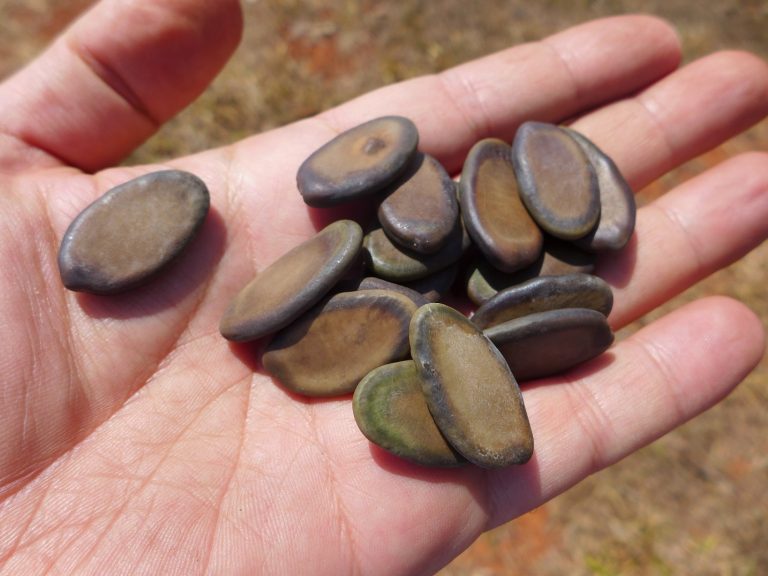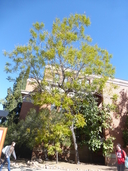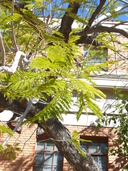(Vell.) S. F. Blake, Fabaceae

|

|

|

|

|
|
(Vell.) S. F. Blake, Fabaceae |
|
Present on Pacific Islands? yes
Primarily a threat at high elevations? no
Risk assessment results: High risk; score: 7 (Hawaii-Pacific Weed Risk Assessment for Schizolobium parahyba)
Other Latin names: Caesalpinia parahyba (Vell.) Allemão; Cassia parahyba Vell.; Schizolobium amazonicum Huber ex Ducke; Schizolobium excelsum Vogel; Schizolobium glutinosum Tul.; Schizolobium kellermanii Pittier; Schizolobium parahyba var. parahyba; Schizolobium parahybrum orth. var.; Schizolobium parahybum orth. var.
Common name(s): [more details]
|
English: Brazilian fire tree, Brazilian firetree |
|
Portuguese: guapiruvu, parica |
Habit: tree
Description: "Schizolobium parahyba* is a strange-looking tree with a tall, slender, often-unbranched trunk topped by a huge cluster of long, fern-like leaves. From a distance it looks like a tree fern, a giant one, for Schizolobium parahyba sometimes attains 30 m." (Tropical legumes, p. 204)
"Unarmed tree with large leaves, yellow flowers in paniculate racemes, a minute stigma, and compressed oblong-cuneate pods dehiscing into two halves and liberating the single apical seed, which remains enclosed in the similar-shaped papery envelope of endocarp resembling a wing." (JSTOR Global Plants)
Habitat/ecology: "Within this wide range of climates [see "Native Range" entry, this ref] it is found in environments from rainforest to dry savanna, from plains to hill slopes, and from fertile to poor soils. It is obviously a very adaptable plant. ¶During its brief blooming season, Schizolobium parahyba becomes a huge mass of color, visible from a great distance; the golden blossoms occur in erect clusters 30 cm tall and it is a prized ornamental. . . . Little is known about this plant's silviculture, but it reproduces well and is easily cultivated." (Tropical legumes, p. 205)
Propagation: "Little is known about this plant's silviculture, but it reproduces well and is easily cultivated." (Tropical legumes, p. 205)
Native range: "The tree is common in the coastal subtropical environment of southeastern Brazil from Rio de Janeiro to Rio Grande do Sul. It also occurs widely in the tropics of Central America as far north as southern Mexico." (Tropical legumes, pp. 204-205)
Schizolobium parahyba (Fabaceae) is native to Mexico, Central America (Belize, Costa Rica, El Salvador, Guatemala, Nicaragua, Panama), and South America (Brazil, Venezuela, Bolivia, Columbia, Ecuador, Peru). (GRIN)
Impacts and invaded habitats: Schizolobium parahyba is cited as naturalized in Puerto Rico. (Invasive species threats in the Caribbean region, p. 121)
Presence:
| Pacific | |||
|
Country/Terr./St. & Island group |
Location |
Cited status &
Cited as invasive & Cited as cultivated & Cited as aboriginal introduction? |
Reference &
Comments |
|
French Polynesia
Society Islands |
Tahiti Island | Consortium of Pacific Herbaria (2018) | |
|
State of Hawaii
Hawaiian Islands |
Hawai‘i (Big) Island | Consortium of Pacific Herbaria (2018) | |
|
State of Hawaii
Hawaiian Islands |
O‘ahu Island | Consortium of Pacific Herbaria (2018) | |
| Pacific Rim | |||
|
Country/Terr./St. & Island group |
Location |
Cited status &
Cited as invasive & Cited as cultivated & Cited as aboriginal introduction? |
Reference &
Comments |
|
Central America
Central America (Pacific rim) |
Central America |
U.S. National Plant Germplasm System (year unknown)
"It [Schizolobium parahyba] also occurs widely in the tropics of Central America as far north as southern Mexico." |
|
|
Central America
Central America (Pacific rim) |
Costa Rica (Republic of) |
native
|
U.S. National Plant Germplasm System (year unknown)
accessed 20171211 |
|
Central America
Central America (Pacific rim) |
El Salvador (Republic of) |
native
|
U.S. National Plant Germplasm System (year unknown)
accessed 20171211 |
|
Central America
Central America (Pacific rim) |
Guatemala (Republic of) |
native
|
U.S. National Plant Germplasm System (year unknown)
accessed 20171211 |
|
Central America
Central America (Pacific rim) |
Nicaragua (Republic of) |
native
|
U.S. National Plant Germplasm System (year unknown)
accessed 20171211 |
|
Central America
Central America (Pacific rim) |
Panama (Republic of) |
native
|
U.S. National Plant Germplasm System (year unknown)
accessed 20171211 |
|
Central America
Central America (non-Pacific rim) |
Belize |
native
|
U.S. National Plant Germplasm System (year unknown)
accessed 20171211 |
|
Mexico
Mexico |
Mexico (United Mexican States) |
National Academy of Sciences (1979) (p. 205)
"It [Schizolobium parahyba] also occurs widely in the tropics of Central America as far north as southern Mexico." |
|
|
Mexico
Mexico |
Mexico (United Mexican States) |
native
|
U.S. National Plant Germplasm System (year unknown)
accessed 20171211 |
|
South America (Pacific rim)
South America (Pacific rim) |
Colombia |
native
|
U.S. National Plant Germplasm System (year unknown)
accessed 20171211 |
|
South America (Pacific rim)
South America (Pacific rim) |
Ecuador (Republic of) (continental) |
native
|
U.S. National Plant Germplasm System (year unknown)
accessed 20171211 |
|
South America (Pacific rim)
South America (Pacific rim) |
Perú (Republic of) |
native
|
U.S. National Plant Germplasm System (year unknown)
accessed 20171211 |
| Also reported from | |||
|
Country/Terr./St. & Island group |
Location |
Cited status &
Cited as invasive & Cited as cultivated & Cited as aboriginal introduction? |
Reference &
Comments |
|
South America (non-Pacific rim)
South America (non-Pacific rim) |
Bolivia |
native
|
U.S. National Plant Germplasm System (year unknown)
accessed 20171211 |
|
South America (non-Pacific rim)
South America (non-Pacific rim) |
Brazil |
native
|
U.S. National Plant Germplasm System (year unknown)
accessed 20171211 |
|
Venezuela
Venezuela |
Venezuela (Bolivarian Republic of) |
native
|
U.S. National Plant Germplasm System (year unknown)
accessed 20171211 |
Comments: Schizolobium parahyba "is grown in Uganda, Tanganyika and Zanzibar (see Dale, Introd. Trees Uganda: 65 (1953), T.T.C.L.: 106 (1949), and U.O.P.Z.: 443 (1949))." (JSTOR Global Plants, from Flora of Tropical East Africa, page 1, (1967) Author: J. P. M. Brenan)
Control: If you know of control methods for Schizolobium parahyba, please let us know.